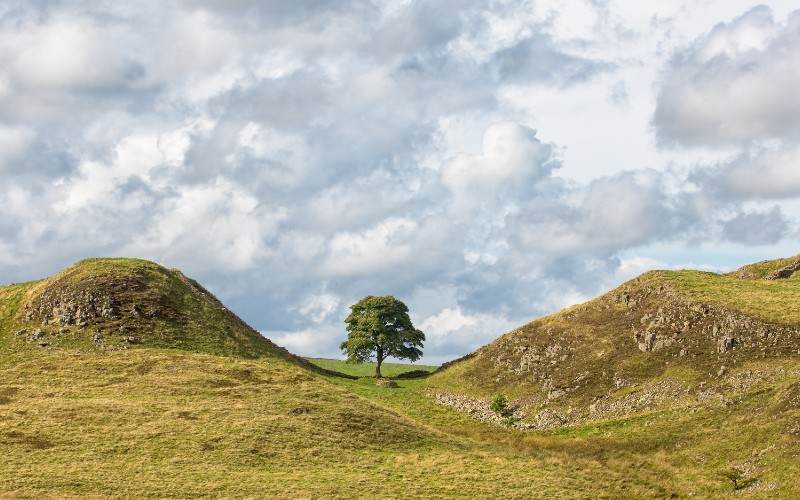
You may have seen recently in the news that a 300 year old tree has been cut down at Hadrian’s Wall. The tree, which has been made famous in films through the years, is often referred to as ‘Sycamore Gap’. Two individuals have been arrested.
Aside from the potential cultural significance of this particular tree or its location, this may have you asking the question “can I cut down trees on my own land?”
Can I cut down trees without permission or a licence?
Generally, you do not require permission to cut down trees in your own garden. In order for ground to be classed as a garden space, you would typically be looking for an enclosed space relating to a residential property, with garden features such as mowed lawns, flower beds, garden buildings or furniture. However, it is not always straight forward, especially with larger gardens or where the boundaries are less defined.
Where trees are clearly not on garden ground, or it is perhaps less clear cut, there are 3 main exemptions that apply where permission is not required:
Size: the threshold for the maximum trunk diameter of small trees that can be felled without permission is 10cm. In order to comply, the diameter is measured at a height of 1.3 metres above ground level.
Volume: you are permitted to fell up to 5 cubic metres of timber per calendar quarter. This is about the size of a regular builders skip, so it might not take many trees to cross this threshold.
Safety: Trees can be felled if the trees in question present immediate danger to persons or property. In practice, this means that if a tree is at risk of falling over, and this would be a danger, then the tree can be felled. This exemption does not apply to nuisance trees (such as trees which cross boundaries), only those which pose a danger.
It is important to remember that uprooted or hanging trees also require felling permission, unless they pose an immediate danger to people, property or infrastructure, or they are blocking roads.
If you rely on an exemption then it is your responsibility to show that you meet the criteria. It is recommended that you keep evidence of what was done and why it was necessary. The easiest way to do this is usually with photos of the trees in question.
If none of the exceptions apply, you will need a licence.
What licence do I need to cut down trees?
It is important to remember that it is an offence in Scotland to fell trees without a licence or one of the exemptions applying. Failing to obtain the relevant licence could lead to prosecution and a fine of up to £5,000.00 per tree.
The types of licence are:
Felling Permission Application: These licences are most suited to small-scale operations and are typically issued for a period of one to two years. Licences of this nature will typically come with a requirement to restock the felled area, and maintain the restocked area until the woodland is properly established again. This is the generally the quickest type of permission, with applications tending to be processed within 12 weeks.
Long Term Forest Plan: As the name suggests, these plans require a more in-depth examination of the woodland area to identify any potential issues and opportunities affecting the forest to ensure compliance with UK Forestry Standards. The planning process typically takes somewhere between 6 and 12 months to complete and will provide felling permission, and details of conditions that should be maintained during the first 10 years of the plan.
Management Plans: There are two types of management plan – Management Plans for woodlands under 100 hectares, and Woodlands in and Around Town (WIAT) Urban Woodland Management Plans. These are similar to the other plan types as they typically last for up to 10 years, however they differ from the others as they generally allow for thinning operations only, and any felling would require a further Felling Permission Application.
Can anyone else cut down trees without permission?
Statutory undertakers, such as Scottish Power, Scottish Water, Network Rail and any other such body, are generally exempt from requiring felling licences. Examples of where these exemptions appear in practice might include trees being felled near power lines or railway lines.
Key points to remember:
- Do I need permission to cut down trees in my own garden? Generally speaking no, as long as it is clearly a residential garden space, however there are special regulations which apply to conservation areas;
- What exemptions are there to felling permission? Trees in private gardens are exempt, and there are exemptions which apply to size, volume and safety. Remember, keep records if you plan to rely on any of these.
- Can anyone else cut down trees without permission? Statutory undertakers, such as utility providers and railway bodies are generally exempt from requiring permission to fell trees.
- What felling licences are there in Scotland? There are three different types: Felling Permission Applications; Long Term Forest Plans; and Management Plans
- It is an offence to fell trees without a licence or an exemption applying. You could be prosecuted and receive a criminal record and a fine of up to £5000.00 per tree;
For further information and advice on tree felling in Scotland please contact a member of Thorntons’ Land and Rural Business Team on 03330 430350.

